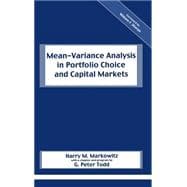
Note: Supplemental materials are not guaranteed with Rental or Used book purchases.
Purchase Benefits
What is included with this book?
| Foreword | ix | ||||
| Preface to Revised Reissue | xv | ||||
| Preface | xvii | ||||
| Part I The General Portfolio Selection Model | |||||
|
3 | (20) | |||
|
3 | (4) | |||
|
7 | (1) | |||
|
8 | (3) | |||
|
11 | (1) | |||
|
11 | (2) | |||
|
13 | (2) | |||
|
15 | (5) | |||
|
15 | (5) | |||
|
20 | (1) | |||
|
20 | (3) | |||
|
23 | (19) | |||
|
24 | (4) | |||
|
28 | (8) | |||
|
36 | (4) | |||
|
40 | (2) | |||
|
42 | (31) | |||
|
42 | (1) | |||
|
43 | (1) | |||
|
44 | (1) | |||
|
45 | (3) | |||
|
48 | (2) | |||
|
50 | (1) | |||
|
51 | (1) | |||
|
52 | (4) | |||
|
56 | (1) | |||
|
57 | (2) | |||
|
59 | (4) | |||
|
63 | (5) | |||
|
68 | (5) | |||
| Part II Preliminary Results | |||||
|
73 | (34) | |||
|
74 | (3) | |||
|
77 | (3) | |||
|
80 | (1) | |||
|
81 | (1) | |||
|
82 | (4) | |||
|
86 | (3) | |||
|
89 | (3) | |||
|
92 | (2) | |||
|
94 | (4) | |||
|
98 | (2) | |||
|
100 | (5) | |||
|
105 | (2) | |||
|
107 | (18) | |||
|
107 | (2) | |||
|
109 | (4) | |||
|
113 | (1) | |||
|
114 | (2) | |||
|
116 | (1) | |||
|
117 | (3) | |||
|
120 | (2) | |||
|
122 | (3) | |||
|
125 | (26) | |||
|
125 | (2) | |||
|
127 | (12) | |||
|
139 | (4) | |||
|
143 | (8) | |||
| Part III Solution to the General Portfolio Selection Model | |||||
|
151 | (33) | |||
|
152 | (2) | |||
|
154 | (3) | |||
|
157 | (4) | |||
|
161 | (5) | |||
|
166 | (5) | |||
|
171 | (3) | |||
|
174 | (2) | |||
|
176 | (2) | |||
|
178 | (1) | |||
|
179 | (5) | |||
|
184 | (15) | |||
|
185 | (6) | |||
|
191 | (2) | |||
|
193 | (2) | |||
|
195 | (4) | |||
|
199 | (26) | |||
|
200 | (2) | |||
|
202 | (12) | |||
|
214 | (2) | |||
|
216 | (3) | |||
|
219 | (4) | |||
|
223 | (2) | |||
|
225 | (18) | |||
|
229 | (7) | |||
|
236 | (2) | |||
|
238 | (1) | |||
|
239 | (4) | |||
| Part IV Special Cases | |||||
|
243 | (32) | |||
|
244 | (4) | |||
|
248 | (5) | |||
|
253 | (4) | |||
|
257 | (2) | |||
|
259 | (3) | |||
|
262 | (3) | |||
|
265 | (5) | |||
|
270 | (2) | |||
|
272 | (3) | |||
|
275 | (26) | |||
|
276 | (1) | |||
|
277 | (3) | |||
|
280 | (2) | |||
|
282 | (2) | |||
|
284 | (2) | |||
|
286 | (2) | |||
|
288 | (13) | |||
| Part V A Portfolio Selection Program | |||||
|
301 | (38) | |||
|
|||||
|
302 | (1) | |||
|
303 | (1) | |||
|
304 | (1) | |||
|
305 | (1) | |||
|
306 | (6) | |||
|
312 | (6) | |||
|
318 | (16) | |||
|
334 | (1) | |||
|
335 | (4) | |||
| Appendix Elements of Matrix Algebra and Vector Spaces | 339 | (22) | |||
|
339 | (1) | |||
|
339 | (2) | |||
|
341 | (2) | |||
|
343 | (1) | |||
|
344 | (2) | |||
|
346 | (2) | |||
|
348 | (1) | |||
|
348 | (2) | |||
|
350 | (7) | |||
|
357 | (4) | |||
| References | 361 | (6) | |||
| Index | 367 |
The New copy of this book will include any supplemental materials advertised. Please check the title of the book to determine if it should include any access cards, study guides, lab manuals, CDs, etc.
The Used, Rental and eBook copies of this book are not guaranteed to include any supplemental materials. Typically, only the book itself is included. This is true even if the title states it includes any access cards, study guides, lab manuals, CDs, etc.